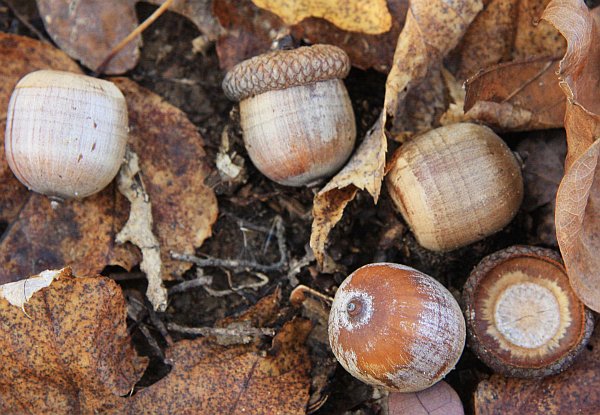
3 October 2013
Stop and listen in Schenley Park right now and you’ll hear acorns falling, blue jays calling and squirrels scurrying. It looks like a bumper crop for acorns in Pittsburgh. (*see p.s.)
Right now the red oaks are putting on a show. Acorns in the white oak group mature in the same year they flower. Acorns in the red oak group take two years to mature so those falling now were formed in the hot spring and summer of 2012, influenced by spring precipitation, summer temperatures and the date of the last killing frost.
Though we (usually*) don’t eat them, acorns are a key link in the woodland food web. They’re so popular that oaks have evolved an abundance-scarcity strategy to throw off their consumers. In some years acorns are so abundant that the crop overwhelms the acorn-eaters. In other years they’re so scarce the consumers go hungry. To further confuse things the oak groups cycle on different schedules: white oaks have a bumper crop in 4-10 years, red oaks on a 3-4 year basis.
Who eats these acorns? Squirrels and chipmunks are the obvious consumers but plenty of other species depend on them including white-footed and deer mice, blue jays, red-headed woodpeckers and wild turkeys. Deer, ruffed grouse, bears, mallards and wood ducks eat acorns, too.
The bumper crops have a ripple effect. A 24-year study, headed by Clotfelter and Pedersen in the southern Appalachian Mountains of Virginia, followed the effects of acorn crops on rodent abundance, raptor abundance and the nesting success of ground-nesting birds. They focused on white-footed mice, deer mice and dark-eyed juncoes and found these amazing acorn effects:
- The population of white-footed and deer mice increases in the year after a bumper crop of acorns.
- Rodents attract predators so the raptor population increases.
- Too many rodents and raptors causes junco nest failure due to predation on eggs, nestlings and birds.
- Mice eat gypsy moths so the gypsy moth population drops.
- The number of ticks increases as white-footed mice and deer increase.
And then, this information from PLOS links acorns to Lyme disease: Lyme disease increases predictably two years after an acorn bumper crop because white-footed mice are a main reservoir for the Borrelia burgdorferi bacteria.
Don’t blame the acorns.
Everything is connected to everything else.
(photo from Wikimedia Commons. Click on the image to see the original)
*p.s. Is this a bumper crop year? I wrote about acorns because I’ve been dodging them in Schenley Park as they fall, but not all the trees are prolific. Hmm….
*”We don’t usually eat acorns”: Well, we can if we put a lot of work into it. See kc’s comment!
I ate acorns one year and had good results. I did a lot of research to figure out how to process them correctly. Here’s what I ended up doing.
I collected big fat green acorns that had recently fallen. I put them on cookie trays and into my oven which has a pilot light in order to let them dry out, until they turned brown (a couple of days to a week or so). I then sliced them open to remove the meat. I discarded any meat that didn’t look up to snuff, discolored or moldy. I put the acorn meats in a blender. I put the blenderized nuts into a bowl. I boiled water in a tea kettle and poured it over the acorn pieces. The water turns brown as the tannins are leaching out. I then drained and repeated the “boiling water trick” until the water did not turn brown anymore. This took a while, maybe 10 goes. Then I put the acorn meal back onto trays and into the oven set as low as it would go in order to dry out the meal.
I ended up making acorn raisin muffins with my meal and they were delicious. It was quite a tedious process (I’ve read that Native Americans put acorns in sacks and then left them in running streams to leach out tannins) and a large bowl of acorns yielded enough acorn meal for one batch of muffins, but it was an interesting experience. I would do it again. I used acorns from a red oak tree as they were readily available. I would like to try white oak as the acorns are supposed to have less tannins.
I brought a muffin in for my co-worker. She enjoyed it and afterword said she felt quite squirrelly.
kc, Oh my! I stand corrected! I forgot that Native Americans ate acorns and that there’s a recipe for them. *I* don’t eat acorns but that doesn’t mean humans never have. My bad!
It’s my first time hearing about acorns in muffins, but I and my family eat plenty of acorns. I used to live in a place full of oak trees and brought acorns to a family church friend who would go through a process to make acorn jelly for us. It is relatively flavorless so we seasoned it. The result is quite savory and good with rice. I’m not sure how the process works, but I’m sure it’s online somewhere.
And nowadays, my mother brings home a box of acorn noodles on a regular basis. We live in California, so there’s a company that gathers acorns from the Sequoia woods and makes them into noodles and probably other foodstuffs.
They are delicious! And very good for you! My mother has diabetes and the acorn pasta is much better for her than wheat pasta would be. We treat it as a substitute in Korean recipes, but the distributor recommended even using it for spaghetti and other pasta recipes.
I’ve never felt squirrelly while eating acorn noodles or jelly…but maybe I will now after reading kc’s comment!
I am certain it does take a lot of work to eat them. I’ve just been enjoying the fruits of others’ labors.